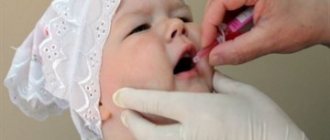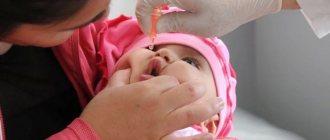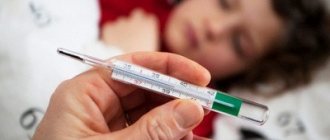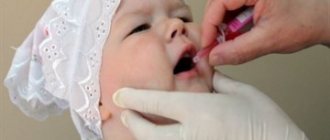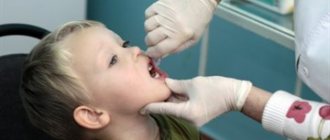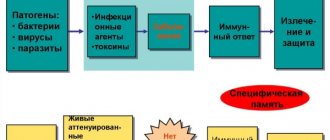Immunization process
For immunization against highly contagious diseases of the nervous system, 2 types of immunobiological agents are used:
- An inactivated drug for subcutaneous or intramuscular administration, prepared from a killed virus. It will not cause VAPP. The vaccine is used to immunize children under one year of age. As a result, they create primary, initial immunity against infantile paralysis.
- A live vaccine prepared from a sharply weakened but living virus. To administer it, you need to drop drops into the child’s mouth. It is used to re-vaccinate children after a year, to maintain the already created immunity. The development of VAPP is associated with the use of the drug.
Vaccine-associated polio can develop:
- in children who have been vaccinated with a live vaccine;
- in persons not vaccinated against infantile paralysis who were in contact with babies who received a live virus.
A weak virus in a healthy child penetrates the intestinal epithelial cell and provokes a stimulating effect on response processes, as a result of which special immunity against polio begins to be developed. These protein compounds in blood plasma prevent the development of the disease and destroy weakened viruses.
Vaccine-associated polio in children develops in an immunodeficiency state (congenital pathology or AIDS). It is prohibited to administer live vaccines to such children.
How is the vaccine different?
There are 2 types of vaccines to prevent the disease. OPV contains a weakened virus cell. Since she is still alive, there is a possibility of developing vaccine-associated polio. The medicine is administered by mouth. Produced in the form of regular drops. Inactivated vaccines are created using dead virus cells.
Advantages of IPV:
- Vaccine-associated polio does not occur with this injection.
- Does not cause intestinal problems.
- 100% immunity to the disease is developed.
Possible consequences of using OPV:
- Vaccine-associated polio may occur.
- The likelihood of infecting others after vaccination, since children secrete live virus after vaccination.
- Intestinal problems appear.
Symptoms of vaccine-associated polio
Symptoms of the disease occur at different times during its course, depending on the route of infection:
- The first signs of the abortive form of VAPP after exposure to a live virus are observed within a month;
- Signs of the vaccine-associated type of infantile paralysis, developed after contact with a vaccinated person, appear within a quarter;
- In children with immunodeficiency, symptoms of VAPP may appear after six months.
Symptoms of VAPP are typical of polio, which is caused by a naturally occurring virus.
The child has the following symptoms:
- temperature rises suddenly and sharply;
- increased secretion of mucus from the nasal cavity;
- the child coughs and sneezes frequently;
- it is possible to increase the level of blood flow to the area of accumulation of lymphoid tissue;
- intestinal dysfunction, manifested in frequent bowel movements;
- the child sleeps poorly and restlessly;
- frequent seizures;
- migraines, etc.
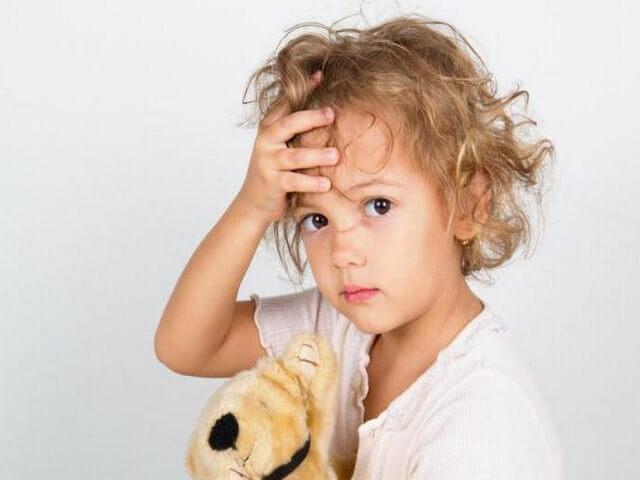
As the disease progresses after oral polio vaccine, the following symptoms are possible:
- lethargy and weakness of muscles and core;
- difficulty coordinating movements and maintaining balance;
- maintaining sensitivity in specified areas;
- the appearance of flaccid paralysis.
With timely treatment, recovery begins after 60 days, and the child’s full recovery occurs after six months, but sometimes the entire rehabilitation procedure takes 2-3 years. In exceptional cases, recovery does not occur and the child becomes disabled. If paralysis of the respiratory tract occurs, death occurs in 90 percent of cases.
Popular Compliance with safety and hygiene rules against leptospirosis
Clinical symptoms are observed between 3 and 31 days of drug administration, but if infection occurs as a result of contact with an infected child, the incubation period can reach two months. If a child’s condition worsens after a routine vaccination against polio, it is necessary to immediately contact a local pediatrician in order to completely prevent fatal consequences!
Forms and signs of VAP
The disease can only occur after vaccination with a live vaccine (OPV). Most often, the development of the vaccine-associated form of polio is observed in children with an immunodeficiency state and a weakened immune system.
There are 3 types of VAP, differing in severity:
- Abortive form - characterized by a mild course. Full recovery is observed after 30 days
- Paralytic form - accompanied by the appearance of paralysis, especially in combination with increased bone fragility
- Disability is the most severe form of VAP, developing as a result of actively progressive muscle atrophy. In particularly severe cases, this form can be fatal.
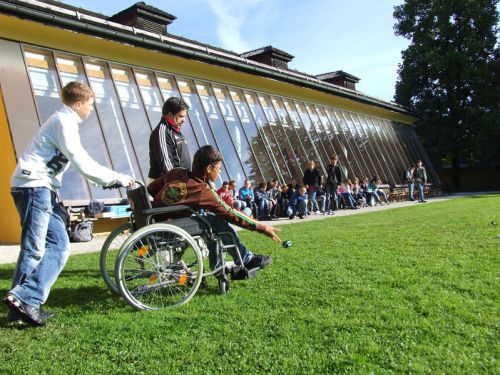
The vaccine-associated form of polio is most often observed in patients with leukemia, HIV, and severe forms of gastrointestinal diseases. This disease is extremely rare in absolutely healthy children.
Diagnostics
The main thing is to determine the form of the disease, calculating the close connection with the administration of the drug. The results of the diagnostic examination must be confirmed by several clinical tests. This will identify the infection of infantile paralysis, as well as the build-up of viral antibodies.
A blood test reveals a high concentration of erythrocyte sedimentation. Analysis of the cerebrospinal fluid will determine critical opalescence, as well as an increased number of mononuclear cells and proteins. A child's stool will reveal two types of virus.
Treatment
Effective therapy that eliminates the cause of polio has not yet been created. The main focus is symptomatic diagnosis. The most commonly prescribed active substances are Securinin, Galantamine, Proserin, gamma globulin, etc. If the respiratory tract is affected, ventilation is prescribed.
If VAPP is detected, the patient is immediately isolated in a medical room with further disinfection of his place of residence. Anyone who has had any contact with the patient must comply with quarantine, and unvaccinated children urgently receive the necessary polio vaccines. The quarantine will end if the adult or child does not show symptoms of the disease for 41 days.
In the case when vaccine-associated polio is accompanied by the development of infantile paralysis, during the rehabilitation period it is necessary to perform massage procedures, physiotherapy, exercise therapy and water training. To increase blood flow, a competent set of exercises is necessary. A set of physiotherapeutic techniques in the lung area prevents their collapse.
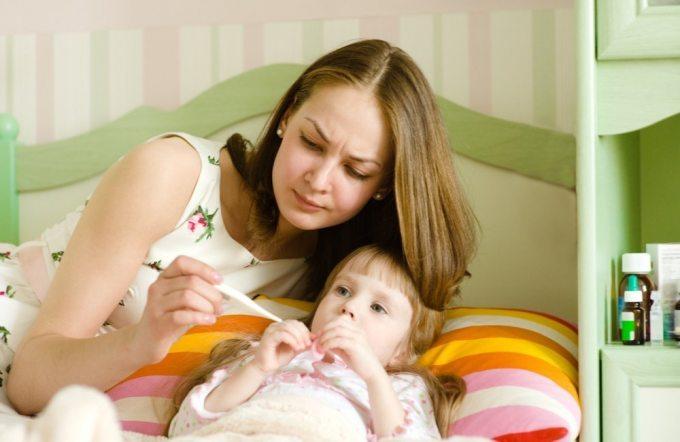
A severe form of the disease can lead to paralysis. This is extremely rare, but this possibility exists, so at the first negative manifestation, you should consult with your local pediatrician!
How does pathology manifest itself in adults?
Poliomyelitis is rarely detected in adults. This often occurs when the baby is sick. It should be taken into account that in a situation where a child has become infected, you can pick up the virus from him within 2 weeks. With a weak immune status, infection occurs from a child if he was given the OPV vaccine.

The symptoms of the vaccine-associated form of the disease are the same as those of the usual pathology in children. Often healthy people do not get sick, but those who have complex illnesses can become infected. Vaccine-associated polio is diagnosed when paresis appears after vaccinations . To confirm, you will have to go for an examination to a neurologist and conduct tests. In such a situation, the number of leukocytes in the circulatory system always increases.
Useful recommendations before vaccination
Before taking drops for infantile paralysis, it is important to comply with the following conditions:
- Children from 2 months of age are recommended to be vaccinated with droplets only a few weeks after using the inactivated vaccine. This is the only way to develop lasting immune responses;
- a woman, while expecting a baby, should not be vaccinated, due to possible pathological disorders in the development of the embryo;
- before the procedure, you must consult a pediatrician to determine possible contraindications;
- during the period of spread of viral infections, as well as other seasonal diseases of mass type, vaccination should be postponed until the epidemiological situation is optimized;
- in accordance with the approved vaccination calendar, mandatory vaccination is carried out for children before adolescence;
- in cases where drops are given to infants and they spit out the dose during instillation, it is necessary to repeat the procedure. If the child spits out or regurgitates droplets again, vaccination must be postponed for 60 days;
- after vaccination, it is forbidden to eat or drink for 60 minutes;
- the drug is extremely sensitive to temperature changes, so it has special marks with a thermometer, which indicates their suitability.
Even minor errors in the rules will not necessarily cause the development of VAPP. The risk of causing undesirable consequences in children is, of course, very high, but even an incomplete course of immunization will allow one to develop lasting protection against the virus.
Popular Infection and first symptoms of lymph node tuberculosis
Preventive measures
To prevent various types of post-vaccination complications, as well as vaccine-associated poliomyelitis, it is necessary to adhere to the established schedule for administering two types of vaccines. Children under 12 months of age who are at high risk of developing diseases are vaccinated intramuscularly or intravenously. In the absence of contraindications, further revaccination will be carried out in drops.
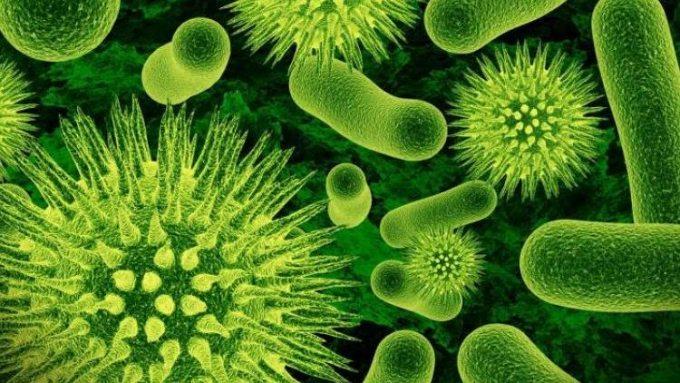
Antibodies that appear as a result of injection of an inactivated drug create strong protection against the disease the next time drops are administered. The exception is babies with congenital immunodeficiency, where the risk of developing the disease remains even with a mixed immunization regimen. For such children, the drug is administered only intravenously or into a muscle.
In addition, prevention includes:
- observation by a doctor during post-vaccination;
- it is necessary to avoid stress and emotional tension;
- you cannot engage in sports or physical activity;
- it is necessary to follow a dietary diet, avoiding fatty, salty, smoked foods, as well as allergenic foods;
- During seasonal ARVI and influenza, it is necessary to avoid places where many children gather and not to take them to kindergarten or school.
Small children and adults should observe hygiene measures, especially children or schoolchildren, since unwashed hands often cause infectious processes. If all conditions and precautions are followed, the chances of developing polio are reduced by 50%.
Today, the opinion of specialists, immunologists, virologists and pediatricians about the need for droplet vaccination against polio is extremely contradictory.
Some argue that the procedure potentially poses a danger to children, since it very often causes various complications. Many pediatricians recommend using only inactivated drugs, without the use of droplets. Other immunologists and pediatricians believe that only droplets can defeat the spread of the virus and, with regular use, reliably protect against mass infections.
State statistics indicate that in the period from 1998-2004, over a hundred cases of vaccine-associated polio were noted in the country, which most often occurred in patients who were not vaccinated. In this case, the infection occurred through contact from previously vaccinated patients. In some cases, this is the reason for refusing early vaccination.

It must be taken into account that almost all democratic countries have abandoned the use of droplets, switching to other inactivated analogues (active substances Pentaxim and Imovax Polio). Laboratory studies have proven that they are more effective than live vaccines and extremely rarely cause complications. The drug demonstrates results in the development of stable immune responses.
The live vaccine should be administered to children over one year of age unless they have contraindications. If the immunodeficiency is congenital or acquired, the use of the drug is prohibited. During the period after the administration of the drops, the child should be observed by a doctor. There is no need to allow psychological stress or the development of infection in the vaccinated person. During this time, it is recommended to follow a hypoallergenic diet.
The state will not save much on polio vaccinations for children
Source: AP Photo/DITA ALANGKARA
The Ministry of Health and Social Development of the Russian Federation replaced the inactivated polio vaccine with a live one, and amended the national vaccination calendar. Live vaccine is domestically produced and cheaper than inactivated vaccine. Experts believe that this is a “step back”, and children will get sick with polio, including vaccine-associated polio, when a live vaccine is used.
Until now, only inactivated vaccine that does not contain viable viruses has been used to vaccinate infants in Russia. It caused practically no side effects, except for extremely rare cases (approximately 1 in 1 million vaccinated children) of vaccine-associated polio. Every child is vaccinated with it at the ages of three, four and a half, six, 18 and 20 months, as well as at 14 years old, if they have no contraindications.
According to the new decision of the Ministry of Health, starting from six months, vaccination will be carried out with a live attenuated vaccine. Until this age, only an inactivated drug remains acceptable.
The department cites the recent polio epidemic in Tajikistan, caused by a “wild” strain of the virus and becoming the largest in the region in recent years, as the reason for the innovation.
According to experts from the Ministry of Health, adequate immunity against such strains is developed only when using an oral attenuated live vaccine. “The transition to a live vaccine is necessary so that children develop intestinal immunity to the ‘wild’ strain of poliovirus,” the ministry says.
According to statistics from the Ministry of Health and Social Development, in 2010, 1.623 million Russian children under the age of one year and more than six million children aged from one to 14 years were vaccinated against polio. In all these cases, an inactivated vaccine was used. Applications for the supply of immune preparations for the 2011 vaccination campaign have already been received from all regions of the Russian Federation, the ministry noted.
Polio
Poliomyelitis is an acute infectious disease caused by the polio virus, characterized by various clinical forms (from mild to paralytic).
The causative agent of poliomyelitis (poliovirus hominis) belongs to the family Picornaviridae, genus Enterovirus. There are 3 serotypes of poliovirus. Poliovirus serotype I (Brünnhilde virus) most often causes epidemic outbreaks with the development of paralysis. Poliovirus serotype II (Lansing virus) is the causative agent of sporadic cases. Poliovirus serotype III (Leon) is characterized by instability of its genotypic structure and virulence, and more often causes vaccine-associated variants of polio.
The virus is stable in the external environment, does not lose viability at low temperatures, persists in water for up to 100 days, in feces for up to 6 months, but quickly dies under the influence of disinfectant solutions, boiling and ultraviolet radiation.
The mechanisms of infection transmission are fecal-oral and droplet. Routes of transmission: food, household contact, water, airborne droplets.
Children aged 3 months and older are most susceptible. up to 5 years. The cause of epidemic outbreaks of polio is a decrease in the immune layer among children aged 3 months and older. up to 1–2 years, which creates conditions for maintaining the circulation of “wild” strains of polioviruses.
Polio remains an epidemic disease (more than 0.1 per 100 thousand population) in southeast Africa, Southeast Asia, India, Bangladesh, and Pakistan. Armenia, Azerbaijan, Tajikistan, Turkey, and Bulgaria are unfavorable for polio. In Russia, the last epidemic rise was registered in 1995, when 153 cases of paralytic poliomyelitis were identified (including 7 deaths).
Immunity lasts throughout life. Repeated cases of the disease are extremely rare when infected with another serological type of virus. Severe paralysis is possible.
Need to be vaccinated
None of the GZT.RU experts argues with the fact that polio vaccinations are needed and collective immunity in the population is needed. Another fact: last year, “neighbors” brought the poliovirus to Russia, and several citizens fell ill on Russian territory.
However, the cheap, domestically produced live vaccine, which will now be used in children over 6 months of age, more often causes cases of vaccine-associated polio. Some experts say there may be even more such cases than cases of polio caused by the wild virus imported from Tajikistan and Uzbekistan. In 2010, when several people in Russia fell ill while campaigning for vaccination, the chief sanitary doctor of the Russian Federation, Gennady Onishchenko, said as an achievement that all Russian children would now receive an inactivated, safer vaccine. Now the situation has “rolled back” to its original position.
Pros and cons
The department's decision has both supporters and opponents. Susanna Kharit, a leading specialist in vaccine prevention at the Research Institute of Childhood Infections of the Federal Medical and Biological Agency of Russia, believes that the right decision was made. “Russian children who will be vaccinated with a “live” polio vaccine in 2011 will receive reliable protection against the “wild” strain of poliovirus, which was discovered in Tajikistan in 2010 and introduced into Russia. However, there is no risk of developing vaccine-associated polio after such vaccination. In extremely rare cases, when using a “live vaccine,” vaccine-associated polio may occur, but only if this is the first or second vaccination, when immunity to the three types of virus has not yet been formed and the virus can behave like a live pathogen.”
In accordance with the National Vaccination Calendar in force since 2011, the first two vaccinations will be carried out using inactivated or “killed” strains, the expert explains, and this provides protection against the development of vaccine-associated poliomyelitis. After two injections of the inactivated vaccine, the child will develop immunity to all three types of polio virus included in the “live” vaccine, says Khait. “And when we “layer” the third vaccine, we, doctors, have no concerns about vaccine-associated polio. This scheme has been used for many years in many foreign countries on the recommendation of WHO and has shown its safety.” Nevertheless, Susanna Khait advises pediatricians in clinics to explain to parents which vaccine is being administered to the child - “live” or inactivated, and mothers, in turn, do not hesitate to ask the doctor about all the pros and cons of a particular vaccine. The difference between “live” and inactivated vaccines is very simple - “live” is dripped into the mouth, and killed is given as an injection.
Children from risk groups are not vaccinated with the “live” vaccine - those who are HIV-infected or whose parents are HIV-infected, as well as children living in closed groups (for example, in orphanages), the expert noted. “This vaccination should not be given to children with primary immunodeficiency, that is: a child is born, and he immediately has pneumonia, sepsis or meningitis, then he constantly has purulent otitis media or something else, or a constantly recurring fungal disease. But, for example, if the mother simply had a difficult birth or perinatal encephalopathy, such children can be vaccinated with “live” polio vaccine.”
Russia was compared to Honduras
“In some countries, both schemes are used,” says Kirill Danishevsky, vice-president of the Society of Evidence-Based Medicine Specialists. “Their effectiveness is approximately equal, but the live vaccine is still more risky. It is used when immunity in the population is low, where there are serious outbreaks of polio. In the US, UK, France, Germany and other countries, experts also believe that the live vaccine can cause polio in some vaccinated children or in immunocompromised children in close contact with recently vaccinated children. And therefore, as a result, in January 2000, the US Center for Disease Control (analogous to the Ministry of Health and Social Development in the Russian Federation, IV) updated its recommendations on the polio vaccine, returning to vaccinations with an inactivated vaccine, acting on the principle: “Children should receive injections with an inactivated virus. Oral polio vaccine should only be used in “special cases.”
Special cases are large outbreaks in unfavorable territories, the departure of an unvaccinated child for a month to zones dangerous for polio, parents’ disagreement with injections (inactivated vaccines are administered only by injection with 4-fold revaccination), the expert explained. “Europeans usually copy the US policy on this issue; Great Britain, France, Finland, Germany and other countries vaccinate the population only with an inactivated vaccine,” Danishevsky said. “There are states (for example, Cuba, Chile) that use mixed schemes.”
WHO does not recommend live vaccines
“The risk of polio infection among Russians from neighbors such as Tajikistan has increased, especially many migrants from there work in Siberia,” Sergei Kolesnikov, Deputy Committee of the State Duma of the Russian Federation for the Protection of Citizens’ Health, told GZT.RU, “but WHO does not “favor live vaccines.” Although I personally cannot evaluate either positively or negatively the decision of the Ministry of Health and Social Development,” the deputy noted. In the future, it is necessary to create a domestic subunit adjuvant vaccine against polio, similar to “influenza,” Kolesnikov believes. By the way, the deputy did not rule out that the decision could benefit domestic producers most of all.
Who is more likely to get complications from vaccination?
Experts explain why parents usually refuse vaccination even with such a crippling infection as polio. “Firstly, the official authorities do not disclose the true picture of post-vaccination complications,” says Pavel Vorobyov, deputy chairman of the Formulary Committee of the Russian Academy of Medical Sciences. “In this case, opacity can only increase the number of refusals and scare off parents even in cases where vaccination is needed.”
Professor, Doctor of Medical Sciences, WHO expert, chief researcher of the Scientific Center for Children's Health of the Russian Academy of Medical Sciences Vladimir Tatochenko previously answered the question about complications during vaccination. “These are children with immunodeficiency for interferon gamma, this is well known to doctors. We usually advise against vaccinating a child if there are family members with immunodeficiency, or if there are cases in the family where children have died for unknown reasons.” Vladimir Tatochenko in an interview with [GZT.RU](https://www.gzt.ru) said: “Since 1997, there has been no polio in Russia. But in 1995, hundreds of cases of paralysis were recorded in Chechnya, all of them in immunodeficient children. If the population had not been vaccinated, there would have been thousands of such cases.” The expert noted the fact that “nowadays an inactivated, not a live, vaccine is used as an achievement of Russia. Such vaccines are significantly more expensive. It costs $6–8, instead of 8 cents, which is the price of a live vaccine. Poliomyelitis exists in African countries, India, and Pakistan. 18 countries imported polio from Nigeria, making it impossible to completely eliminate vaccination. In Russia, the vaccine is prepared from French raw materials; of course, it is more expensive than the old one. We have about 10 cases of complications per year regarding vaccination against polio.”
How much will the state save on the vaccine?
Experts doubt that the state will save significantly on a live vaccine. “If we compare the price of the cheapest vaccine from the company Sanafi-Aventis, then the live vaccine will be approximately 2 times cheaper, if compared with the Glaxasmithklein vaccine - 3-4 times,” explains vice-president of the society of evidence-based medicine specialists Kirill Danishevsky .— This will result in savings of less than 300 million rubles per year. So, most likely, this is not the amount due to which this decision could be made, the expert suggests. Another thing is that the live vaccine is produced in Russia, it is not imported, and this may be lobbying by the domestic pharmaceutical industry, the implementation of the “Pharma 2020” import substitution program.”
The expert believes that it is necessary, at least, to transfer the money saved when switching to a live vaccine to compensate children who will receive adverse reactions from vaccinations with a live vaccine, even if there are only a few such people, now these compensations are “simply ridiculous” - per year 1 thousand rubles. In general, Danishevsky assessed this decision of the Ministry of Health and Social Development as “premature.”
Those who refuse vaccinations will be unwittingly “infected”
There is another reason that may be hidden when making such a controversial decision. Experts say that when vaccinated with a live vaccine, even those children who were not vaccinated, whose parents, for example, refused vaccination, become infected, so immunity still appears even in those who are not vaccinated. This may be attractive for the organizers of a vaccination campaign: individual refusals will have less of an impact on protecting the population, and there is no need to persuade each parent separately, and bonuses based on the results of the vaccination campaign will not be affected. But in any case, vaccination with a live vaccine raises many additional social problems. “In kindergartens, they will either have to send unvaccinated children home for a month, or organize isolated groups,” says Pavel Vorobyov, “and cases of going to court if a child is not allowed into the kindergarten are becoming more frequent.”
Irina Vlasova gzt.ru
How do you feel about mandatory vaccination?
- Positively, it prevents many diseases. 60%, 2641 votes
2641 votes 60%2641 votes - 60% of all votes
- Negatively, these are all government schemes to make it easier to manage us. 26%, 1157 votes
1157 votes 26%
1157 votes - 26% of all votes
- Neutral, I don’t think it has any effect on my health. 13%, 592 votes
592 votes 13%
592 votes - 13% of all votes
Total votes: 4390
Votes: 4365
January 17, 2018
×
You or from your IP have already voted.

